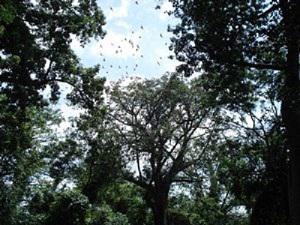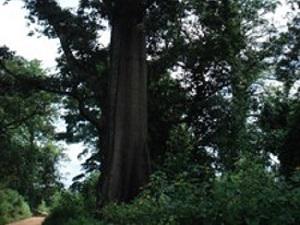Nelson Abila
This project aims to implement a participatory conservation of biodiversity in the oldest existing primary forest habitats in Oke-Ogun Area of Oyo State, Nigeria.

African Giant Bats that breeds in the forest.
The project is sited in the Oke-Ogun area of Oyo State, Nigeria. This area is at the fringes of the border between Nigeria and Benin Republic. The King’s Forests are the oldest existing forests in Oke-Ogun, an area suffering an increasing rate of desertification with high loss of indigenous plants and animal species especially the African giant bats, other birds and essential timber and cultural trees such as Milicia exclesa (iroko) and Ceiba pentandra (araba).

Picture of Ceiba petandra (Araba) an endangered timber tree in Nigeria.
The king’s forests hold some of the historical facts about the Yoruba race in southwestern Nigeria and antiquities useful for research on various issues relating to the community, their emergence and development. The forests have been protected over the years as a result of their sacredness – cultural rite and the essence ascribed to their existence by the virtue of the fact that they serve as the King’s tomb. The project will ensure the preservation of the forests as in-situ conservation and genetic bank for many highly endangered trees and plant species most of which have economic importance ranging from timber to medicinal value. The project will also ensure that the forests continue to serve as brooding place and source of food and shelter for endangered birds and animals.
With the increasing loss of those cultural values, the forests are under threat. The project will stimulate and ensure local ownership and sense of commitment to the preservation of the forests for the derivation of ecosystem services such cultural, aesthetic and socio-economic values derivable from them.
The project will conduct series of consultation and meetings with stakeholders, collate and document information on the history of the forest, conduct mapping, identification, labelling and tagging of species, construct perimeter fence, conduct community level conservation education and training, media sensitization and stimulation of tourism and derivation of other ecosystem services. The project will also ensure the development of a management plan for the forest. As subsequent conservation and recovery efforts particularly ex-situ conservation of trees and plants in the forest depends on the preservation of only existing ones for their seeds, the project will ensure the preservation and protection of the forest. This will be done through a re-awakening of the sacredness, cultural, biological, environmental/ecological as well as socio-economic importance of the forests and their conservation to the community members, particularly custodians to ensure total community support and guarantee a long-term conservation.